Laptop Mag Verdict
Although Dell's first 11-inch ultraportable performs well, competing notebooks offer longer battery life and better ergonomics for less money.
Pros
- +
Wide range of color and design options
- +
Very good audio quality
- +
Decent HD video playback
Cons
- -
Expensive
- -
Below-average battery life
- -
Oversensitive touchpad
- -
Underside runs hot
Why you can trust Laptop Mag
The 11-inch notebook category is heating up, with all the major manufacturers now offering netbook alternatives with bigger screens and keyboards. The sleek 11.6-inch Dell Inspiron 11z joins the party with a wide range of personalization options, along with a ULV processor that can handle HD video. Pricing starts at a very netbooky $399, but the $654 configuration we received raises serious questions about this laptop's value. Yes, the 11z easily outperforms Intel Atom-based machines, but how does this Dell stack up against the competition?
Design
Weighing just 3.4 pounds and measuring 11.5 x 8.4 x 0.9 inches, the Inspiron 11z is a light, svelte machine with an attractive profile. It shares nearly identical dimensions with the equally attractive Lenovo IdeaPad S12 netbook. The Acer Aspire 1410 is 0.2 inches thicker, as is the HP Mini 311, but both of those systems are 3.2 ounces lighter as well.
The 11z comes standard with a black lid, but you can choose from six color options that add $40 to the cost. Our review unit came with a glossy green lid that we were happy to find didn't show many fingerprint smudges. Other color options include blue, pink, purple, red, and white. If you want to personalize your ultraportable further, Dell offers over 200 unique lid designs ($65) you can custom order, from Big Giant Plaid to your favorite MLB team.
The plastic deck is simple and straightforward: the power button sits above the keyboard on the left side. There's just one light on the bottom left area of the wrist rest, indicating power. Unfortunately, Dell didn't include a light to indicate Wi-Fi status, which we would have found helpful.
The six-cell battery on our configuration raised the unit about an inch in the back, providing a comfortable downward slope.
Heat
Whenever we had the 11z in our lap, the system got uncomfortably hot underneath in a short amount of time. Even when sitting on hard surfaces, the left underside near the vent was always noticeably hot. We knew the notebook's fan was working, though, because we heard its constant whine whenever the system was on.
After the 11z sat idle for five minutes, we played The Daily Show on Hulu at full screen. Within 15 minutes, the touchpad was 88 degrees Fahrenheit, and the space between the G and H keys was 95 degrees. When we measured the bottom of the unit near the air vent, the thermometer registered 104 degrees; air coming from the vent got up to 109. Temperatures below 95 degrees are acceptable; we consider anything over 100 degrees to be a cause for concern.
Keyboard and Touchpad
Due to the 11z's 92 percent of full-size keyboard, we were able to reach our normal typing speed right away (though we committed far more errors than usual). The slightly rough-textured keys on the 11z are also flat, lacking the familiar slight dip in the center. It's too easy to hit the wrong key on the 11z or accidentally hit two at once. Even after playing with the system for a couple of days, we still experienced a high error rate. The key size seems to be the culprit, as is the small space between each, and when combined these elements offer no slack for slightly inaccurate typers. We didn't have this problem with the Acer Aspire 1410's keys, which are about an eighth of an inch bigger and have more space between them.
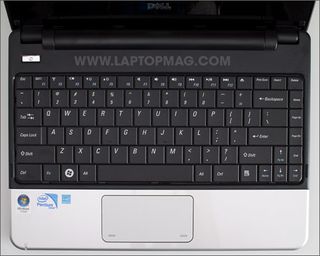
Click to enlarge
Otherwise, keys offer snappy return and good travel. Placement is also good; the Shift key is a bit undersized to make room for the up arrow, but it's in the correct position. Alt, Ctrl, and Fn keys are sized well on both the left and right, making things easy for frequent shortcut users. We also appreciate the dedicated End, Home, and Page Up and Down keys on the right.
We're pleased to see that the Function keys along the top row have been reversed so that you don't need to press the Fn key to control brightness, multimedia playback, volume, and Wi-Fi.
The 3.5 x 1.8-inch touchpad is also like the one found on the Dell Mini 10--and reminiscent of the MacBook Pro--as the mouse buttons are integrated into the touch surface. The bottom corners of the touchpad are clickable, indicated by two oblong markers on the left and right. While we liked the larger surface area, we found it to be overly sensitive. When we'd try to do something as simple as click and drag or scroll down a Web page, the touchpad would interpret the movement as a pinch or zoom about two-thirds of the time.
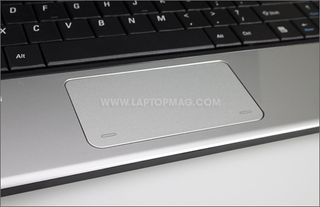
Click to enlarge
In the options page for the Elan touchpad driver (found in the Control Panel) users can access customization options and enable or disable any of the gestures. However, while there are sensitivity sliders on the PalmTracking software (which keeps the mouse cursor from jumping due to accidental contact), there is no way to fine-tune the sensitivity of the touch surface itself; we had to turn off some of the multitouch features just to make using the touchpad bearable.
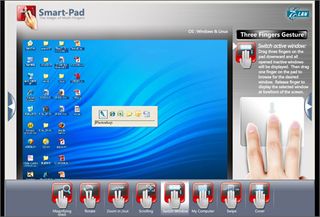
Click to enlarge
Powered by Elan Smart-Pad software, the touchpad is capable of multitouch gestures beyond two-finger scroll or pinch-and-zoom. Elan's tutorial demonstration of the eight gestures the touchpad is capable of was very helpful. It showed us how to execute the three-finger window switch, as well as how to quickly minimize all windows by placing your palm on the touchpad. The level of functionality and complexity also reminded us of the MacBook. Unfortunately, Dell's multitouch isn't as easy to use.
Display and Audio
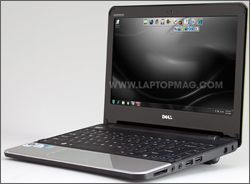
Click to enlarge
The glossy 11.6-inch, 1366 x 768-pixel resolution display offers vibrant colors and deep blacks. Vertical viewing angles were very good. The screen tilts back about 135 degrees, and we encountered no color distortion at that range. Horizontal viewing angles could be better; two people can comfortably watch a video on screen together, but beyond that the screen becomes difficult to see clearly.
While playing the 720p trailer for The Discoverers, downloaded from the Microsoft WMV HD Content Showcase, we noticed a very slight hitch in playback during slow scenes. We also saw this when streaming Legend of the Seeker in HD from Hulu. Aside from this minor drawback, the 11z handled high-definition content well. Standard definition videos always played smoothly, both from the hard drive and online.
Despite being located underneath the front of the system and directing all sound at the surface beneath, the 11z's speakers produced clear, loud audio. While listening to "Where is Bobby Gentry?" by Jill Sobule with the volume at 33 percent, the song easily filled a small room. At 50 percent we heard the folksy singer's voice and guitar clearly, even with a high-powered fan running next to us. The bass line in Superchick's "One Girl Revolution" was present, if not very strong. We discerned multiple layers of sound and instrumentation in Kerry Ellis' rock version of "Defying Gravity."
Ports and Webcam

Click to enlarge
The 11z has the standard array of ports for a notebook of this size. Ethernet, one USB, and HDMI on the left; power, two more USB, headphone, mic, and a 3-in-1 memory card slot on the right. We like the inclusion of an HDMI port, but don't appreciate how SD Cards stick out about half an inch from the system and aren't secured by a spring lock.

Click to enlarge
A 1.3-megapixel webcam sits above the display and captures decent images. Before chatting with a friend on Skype, we were able to adjust the brightness, contrast, and color settings to achieve a good image that came through clearly on the other end. Our friend did notice a slight blur whenever we moved, but otherwise the camera performed well.
Performance
The 1.3-GHz Intel Pentium SU4100 CPU and 2GB of RAM earned the system a score of 2,442 in PCMark Vantage, a benchmark that tests overall performance. This is not only below the average ultraportable score of 2,766, but it's almost 300 points below the Gateway EC1430u, a ULV system with the same processor but 3GB of RAM. The Inspiron 11z is just a few points behind the Acer Aspire 1410 (2,475), which has a dual-core Intel Celeron SU2300 CPU, but it trounces the Toshiba Satellite T115 (1,453), which has a 1.3-GHz Intel Pentium SU2700 processor. Anecdotally, we experienced good performance while switching between CoolPlayer, Google Chrome (with up to 8 tabs open), OpenOffice Writer, Skype, and Windows Media Player.
The 5,400-rpm, 250GB hard drive is fairly fast, completing the LAPTOP Transfer Test in 3 minutes and 52 seconds for a rate of 21.9 MBps, which is 1.0 MBps faster than the average. It's also speedier than the Aspire 1410 and the Satellite T115 (19.6 and 19.4 MBps, respectively), and comes in just a hair below the Gateway EC1430u's score of 22.2 MBps. When it came time to boot, however, the 11z fell behind, loading Windows 7 Home Premium in 65 seconds--4 seconds longer than the average netbook and 10 and 5 seconds slower than the Aspire 1410 and EC1430u, respectively. The 11z did much better than the Satellite T115, though, which took a pokey 1 minute and 45 seconds to boot.
When we transcoded a 114MB MPEG-4 video clip to AVI (using HandBrake), it took 13 minutes and 11 seconds for the 11Z to finish, which is a little faster than the average of 13:39 and almost 10 minutes faster than the Satellite T115. The 11z still took longer than the Aspire 1410 (12:47) and the EC1430u (11:33).
Despite strong video playback performance, the 11z's integrated Intel GS45 graphics only scored 551 on 3DMark06. That puts the system far behind the average ultraportable's score of 857. Compared to other ULV notebooks, this system's score is closer to (but still behind) the Aspire 1410 and Satellite T115 (595 and 635, respectively). It beats the EC1430u, but only by 8 points.
When taking a sightseeing tour in Google Earth with 3D buildings, the 11z took 30 to 60 seconds to render some 3D objects, though it managed to fill in the surrounding area with recognizable 2D elements within 15 seconds. Flying from one location to another was smooth; it was only when we arrived at each location that the notebook had to work hard to render the graphical elements.
Wi-Fi and Battery Life
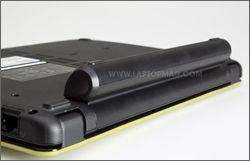
Click to enlarge
At 15 feet from the router, Dell's Super Wireless-N card delivered throughput of only 19.6 Mbps. That's slightly below the ultraportable average (20.4), but is still good enough for speedy downloads and streaming content from Hulu or YouTube. However, the 11z's 15 foot score was not only below the ultraportable average, but below the Aspire 1410 (19.9 Mbps), EC1430u (20.3 Mbps), and Satellite T115 (24.7 Mbps). The 11z fared better at 50 feet with a throughput of 18.3 Mbps, beating out the 17.1 Mbps average.
Battery longevity was also a disappointment, as the 11z only lasted 4 hours and 56 minutes on a charge. That's about a half an hour below the ultraportable average, and outright dismal compared to other ULV systems. The Aspire 1410 lasted 6:33; the EC1430u managed 8:11; and the Satellite T115 went for 7:08.
Green Tests
The Inspiron 11z took 3 hours and 12 minutes to fully charge. It consumed a total of 6124.8 watts, for a LAPTOP Battery Efficiency Rating of 20.7 (total watts divided by battery life; lower is better). Of the ULV systems we've tested in the past six months, the 11z is the least efficient, scoring above the overall ultraportable average (19.4) as well.
Software and Warranty
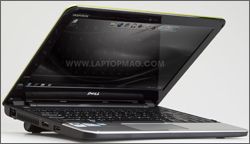
Click to enlarge
Our review unit came with Windows 7 Home Premium (64-bit), the Windows Live Suite, and the Microsoft Works 9 office suite. 15 months of McAfee Security Center is also included. Dell bundles a standard spread of branded software with the 11z, including the Dell Dock and Dell Webcam Central, which includes fun features for adding effects and avatars to video chats. Utilities include Elan SmartPad options, Dell DataSafe Local Backup, and Dell Wireless WLAN Card.
We liked the FastAccess Facial Recognition software. It was easy to set up, and allowed us to log in by just looking into the webcam. The program was accurate each time we tried, logging in less than a second after our face was in the right position and never confusing our face with a coworker's.
The Inspiron 11z comes covered with a limited one-year parts-and-labor warranty with mail-in service. Warranty extensions are available up to three years with remote and in-home service as well. Click here to see how well Dell did in our Customer Support Showdown.
Configurations
Although the Inspiron 11z we reviewed costs $683 (with the default Obsidian Black color for the lid), the base configuration starts at $379, and gets you a 1.3-GHz Intel Celeron 743 CPU, 2GB of RAM, 802.11a/b/g Wi-Fi, three-cell battery, a 5,400-rpm, 160GB, hard drive, and a webcam without facial recognition software. The Fast Track configuration ($429; ships the next day) has the same CPU, RAM, Wi-Fi card, and battery as the base config, upgrading to a 250GB hard drive and 15 months of McAfee Security Center. The Staff Pick configuration--$529--adds Dell's Super Wireless-N card, ups hard drive space to 320GB, and adds a six-cell battery plus a two-year Basic Service Plan warranty.
Starting from our $683 configuration, consumers can opt for Windows Vista for $30 less; upgrade from 2GB to 4GB of RAM for $120 more; downgrade from 250GB to a 160GB hard drive to save $25; ditch the Wireless N for 802.11a/b/g and subtract $25; add 24 or 36 months of McAfee for $25 and $40 (or skip it completely and save $89); and downgrade from a six-cell to a three-cell battery for $35 less (though we wouldn't recommend it). A combo WiMAX/Wi-Fi card is available for Vista configurations, or you can add AT&T mobile broadband with GPS for another $125 (plus data charges).
You can get the price down to a more reasonable $519 by ditching the 15 months of McAfee and the facial recognition software, then opting for the 160GB hard drive and the 802.11a/b/g wireless card over Super Wireless-N.
Verdict
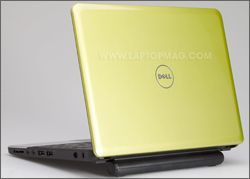
Click to enlarge
Dell's Inspiron 11z laptop is lightweight and attractive, but it simply costs too much for what you get. Not only does the touchpad implementation leave something to be desired, but other systems in this class offer better performance and much longer batter life for less money. Both the Gateway EC1430u and the Acer Aspire 1410 best the 11z in most benchmarks and cost $130 to $280 less, with the latter offering a better keyboard and touchpad to boot. Though its design will stand out in the crowd, the Inspiron 11z fails to impress overall.
Dell Inspiron 11z Specs
| Brand | Dell |
| CPU | 1.3-GHz Intel Pentium SU4100 |
| Company Website | http://www.dell.com |
| Display Size | 11.6 |
| Graphics Card | Intel GS45 |
| Hard Drive Size | 250GB |
| Hard Drive Speed | 5,400rpm |
| Hard Drive Type | SATA Hard Drive |
| Native Resolution | 1366x768 |
| Operating System | MS Windows 7 Home Premium (64-bit) |
| Ports (excluding USB) | Microphone, Headphone, HDMI, Ethernet |
| RAM | 2GB |
| RAM Upgradable to | 4GB |
| Size | 11.5 x 8.4 x 0.9 inches |
| USB Ports | 3 |
| Video Memory | 796MB |
| Warranty/Support | One-year limited parts-and-labor/24/7 toll-free phone |
| Weight | 3.4 pounds |
| Wi-Fi | 802.11n |
